The $60 CPU Question: AMD Athlon 200GE or Intel Pentium Gold G5400? A Review
by Ian Cutress on January 14, 2019 8:00 AM ESTCPU Performance: Encoding Tests
With the rise of streaming, vlogs, and video content as a whole, encoding and transcoding tests are becoming ever more important. Not only are more home users and gamers needing to convert video files into something more manageable, for streaming or archival purposes, but the servers that manage the output also manage around data and log files with compression and decompression. Our encoding tasks are focused around these important scenarios, with input from the community for the best implementation of real-world testing.
All of our benchmark results can also be found in our benchmark engine, Bench.
Handbrake 1.1.0: Streaming and Archival Video Transcoding
A popular open source tool, Handbrake is the anything-to-anything video conversion software that a number of people use as a reference point. The danger is always on version numbers and optimization, for example the latest versions of the software can take advantage of AVX-512 and OpenCL to accelerate certain types of transcoding and algorithms. The version we use here is a pure CPU play, with common transcoding variations.
We have split Handbrake up into several tests, using a Logitech C920 1080p60 native webcam recording (essentially a streamer recording), and convert them into two types of streaming formats and one for archival. The output settings used are:
- 720p60 at 6000 kbps constant bit rate, fast setting, high profile
- 1080p60 at 3500 kbps constant bit rate, faster setting, main profile
- 1080p60 HEVC at 3500 kbps variable bit rate, fast setting, main profile
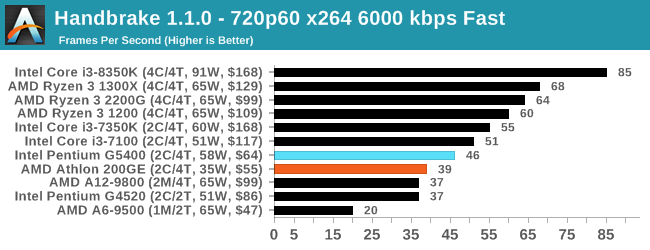
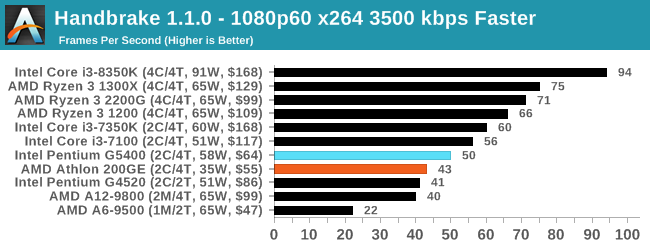
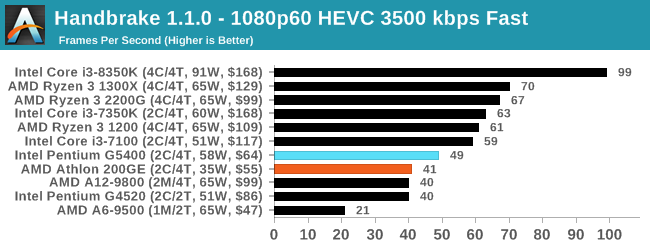
Handbrake manages to use the Pentium resources and higher frequency better, scoring about a 15% win in every circumstance.
7-zip v1805: Popular Open-Source Encoding Engine
Out of our compression/decompression tool tests, 7-zip is the most requested and comes with a built-in benchmark. For our test suite, we’ve pulled the latest version of the software and we run the benchmark from the command line, reporting the compression, decompression, and a combined score.
It is noted in this benchmark that the latest multi-die processors have very bi-modal performance between compression and decompression, performing well in one and badly in the other. There are also discussions around how the Windows Scheduler is implementing every thread. As we get more results, it will be interesting to see how this plays out.
Please note, if you plan to share out the Compression graph, please include the Decompression one. Otherwise you’re only presenting half a picture.
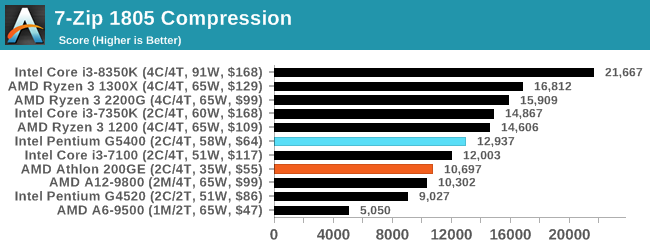
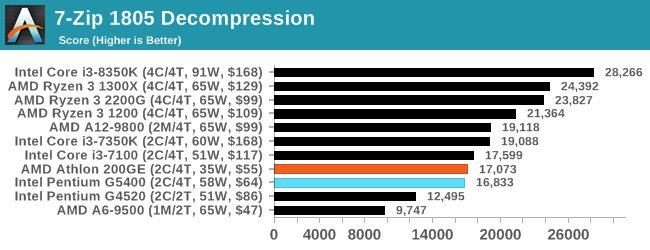
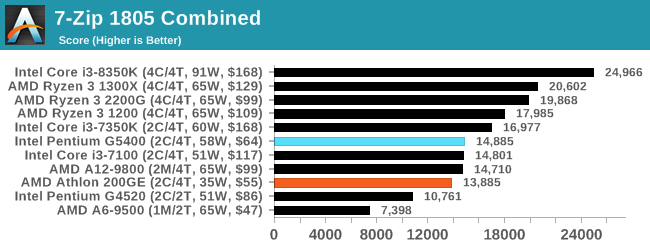
7-zip is an interesting test, given that Intel usually wins Compression but AMD wins Decompression. The same occurs here, however Intel wins the first test by a lot and AMD wins the second test by a small margin. Overall win to Intel here.
WinRAR 5.60b3: Archiving Tool
My compression tool of choice is often WinRAR, having been one of the first tools a number of my generation used over two decades ago. The interface has not changed much, although the integration with Windows right click commands is always a plus. It has no in-built test, so we run a compression over a set directory containing over thirty 60-second video files and 2000 small web-based files at a normal compression rate.
WinRAR is variable threaded but also susceptible to caching, so in our test we run it 10 times and take the average of the last five, leaving the test purely for raw CPU compute performance.
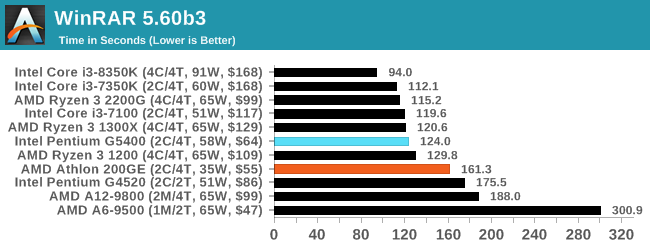
As a mixed workload that involves memory, this result would seem hard to predict given the two CPUs being tested. It ended up a clear win for Intel however – that extra core frequency in the G5400 mattered more than the main memory frequency of the 200GE.
AES Encryption: File Security
A number of platforms, particularly mobile devices, are now offering encryption by default with file systems in order to protect the contents. Windows based devices have these options as well, often applied by BitLocker or third-party software. In our AES encryption test, we used the discontinued TrueCrypt for its built-in benchmark, which tests several encryption algorithms directly in memory.
The data we take for this test is the combined AES encrypt/decrypt performance, measured in gigabytes per second. The software does use AES commands for processors that offer hardware selection, however not AVX-512.
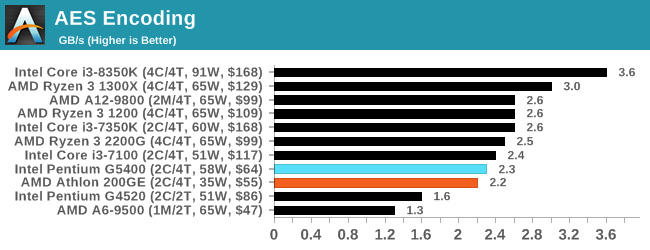










95 Comments
View All Comments
mczak - Monday, January 14, 2019 - link
Yes, I'd expect at least the Athlon to be quite close to its TDP with simultaneous CPU+IGP load.The Pentium probably not really (although the Pentium G5500/G5600 could get close, as these have the GT2 (UHD 630) rather than the GT1 (UHD 610) graphics, which also should be much more competitive with the Athlon).
biiiipy - Monday, January 14, 2019 - link
In my country the cheapest I can find is 200GE for 50€ andG5400 for 90€... yeah...ET - Monday, January 14, 2019 - link
Very nice to see a low end comparison, and a quite comprehensive one at that.What I don't understand is why quite a few benchmarks (especially on the IGP tests) are missing some of the CPUs.
Rudde - Monday, January 14, 2019 - link
The test setup table doesn't include the G5400.shabby - Monday, January 14, 2019 - link
The g5400 is $183 on amazon...T1beriu - Monday, January 14, 2019 - link
You should have measured the power consumption for 100% CPU load + 100% GPU load, lile POV + Furmark?Flunk - Monday, January 14, 2019 - link
These are close enough that I would buy whichever I could get cheaper (with a compatible board of course).Targon - Monday, January 14, 2019 - link
Of course, if you are looking to start low but then upgrade later, socket AM4 will allow upgrades from the lowest end to top end.edzieba - Tuesday, January 15, 2019 - link
So could the Pentium, right to the 9900k.eastcoast_pete - Monday, January 14, 2019 - link
@Ian: thanks, and I agree with your conclusion, but only if the ~$60 mark is a hard upper limit. Take-home for me: if you believe that you're going to be working and gaming on the iGPU of the chip even for a few months, try as hard as you can to get the extra $40 and buy the Ryzen 2200 G instead, which retails for $99 or so. That is still the value king here, and by a big margin. Unlike either the Pentium or the Athlon, the 4 cores and the (much beefier) iGPU of the 2200G can provide the 25-30 frames/second in many of the games tested here, has generally superior performance on non-gaming applications as well, and, once the dedicated graphics card arrives, it still gives a better showing than either Athlon or Pentium. Plus, as Gavin here and others on their sites have shown, there is significant headroom left for overclocking if that extra 10% or so is a must-have. So, long in short: For a budget system, and if at all possible, get the Ryzen 2200G. It is well worth the 40 bucks more.